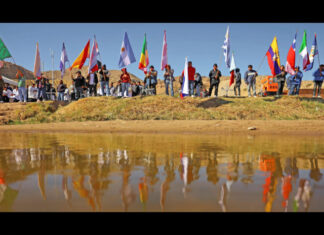The most impactful thing about El Sueño Americano, the photographic exhibition on view at the ArtsXchange gallery (in the Warehouse Arts District) Oct. 8 through Nov. 5, is that it puts a face on the raging debate about illegal immigration – without depicting any faces at all.
El Sueño Americano (The American Dream) consists of photographs, by former border patrol station janitor Tom Kiefer, of personal items confiscated from men, women and children who were apprehended while attempting to cross from Mexico into Southern Arizona.
 “The policy,” explains the 59-year-old Kiefer in a telephone interview, “was that anything considered non-essential, or potentially lethal, the migrants had to give up. It was confiscated and thrown in the trash.”
“The policy,” explains the 59-year-old Kiefer in a telephone interview, “was that anything considered non-essential, or potentially lethal, the migrants had to give up. It was confiscated and thrown in the trash.”
Over an eight-year period, Kiefer collected hundreds of wallets – some with photo IDs intact – bibles, rosaries, items of clothing, toys, books, blankets, brushes and combs, and less personal items including bars of soap, toothpaste and toothbrushes, along with roll upon roll of toilet paper.
Wherever those apprehended wound up, their property was never returned.
“Everyone has an opinion on this,” offers Kiefer, whose initial task had been to extract packages of pre-packaged food from the dumpster, and bring them to a local food bank. “But the taking of a rosary or a bible, there’s just something inhumane and morally wrong about that.”
Ironically, Kiefer had only hired on because he couldn’t make ends meet pursuing his passion – making black and white art photographs of the American urban landscape.
He went to work at the Customs and Border Protection center in Why, Ariz. in 2003. “I was already an artist; it could not have been scripted more perfectly,” he says.
The food-donation system was already in place when Kiefer arrived; it intensified during his tenure, and he was put in charge. Which is when he began to discover more than cans of tuna and bags of chips during his dumpster-diving expeditions. Even then, he says, “It was five years before I figured out a way in which I could present these items in a way that was respectful and neutral.”
 During those five years, Kiefer stored the found objects in a friend’s garage; he knew the Border Patrol wouldn’t be thrilled if they knew what he was doing.
During those five years, Kiefer stored the found objects in a friend’s garage; he knew the Border Patrol wouldn’t be thrilled if they knew what he was doing.
What was he doing? At first, he wasn’t sure.
Kiefer began to see the migrant material as silent witnesses to lives irrevocably changed, evidence that American immigration policies were flawed.
“This was an object that someone chose to carry with them,” he says. “Of all the things to carry as they risked their lives crossing the desert, this was it. When I first came across a bottle of cologne, I couldn’t believe it. I thought ‘Why in God’s name are they bringing a bottle of cologne?’ I thought it was crazy.
“But I continued coming across bottles of cologne. This bottle of cologne represented something to them, their hopes, their dreams. Getting ready for their first job interview, or being reunited with someone they hadn’t seen in years. It was a symbol, a talisman of hope, or their new life so to speak.”
He began to arrange and photograph the items, and resigned – “before they could fire me” – in 2015. “My job,” he explains, “is to engage the viewer, and to have them linger and think about what they’re looking at.
 “If the viewer can engage and start thinking about ‘Who was this person?’ And ‘Oh my God, that’s the cologne I use. The toothpaste I brush my teeth with.’ We are human beings.”
“If the viewer can engage and start thinking about ‘Who was this person?’ And ‘Oh my God, that’s the cologne I use. The toothpaste I brush my teeth with.’ We are human beings.”
Although they aren’t part of the St. Petersburg exhibition, Kiefer has recently begun using actual photographs recovered from the dumpster. They’re passport-type photos. It took him a while to add the faces, he says, “because I didn’t know who these people were. I didn’t know if I would somehow be putting their life at risk.
“But at the same time, it cried out for putting the human face on this. Something like a driver’s license or a photo ID, I don’t think that I would ever do that.”
Unfortunately, there are no plans for Kiefer to make an appearance at the Arts Xchange. “This is still a self-funded project,” he explains, “but I’m very resolute about it. I could never have planned out my career in this way. The plan was to continue photographing America, using black and white film photography. Kind of in the vein of Walker Evans, who was one of my heroes.
“But it certainly didn’t turn out that way. And it’s an absolute honor to have come across this project. It could not have been more organic. El Sueño Americano really feels like it has a life of its own.”

Photographer Tom Kiefer










